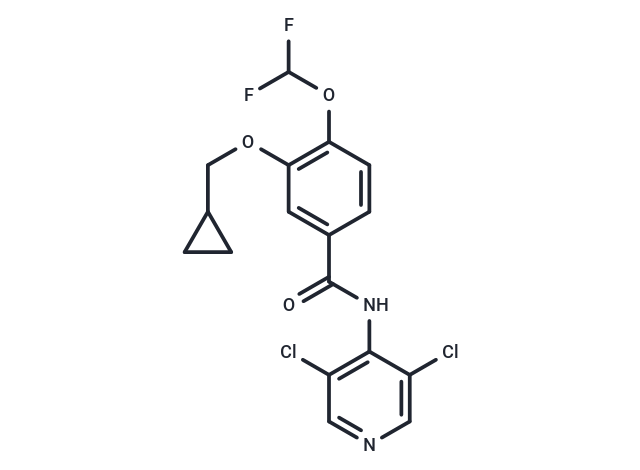Shopping Cart
Remove All Your shopping cart is currently empty
Your shopping cart is currently empty
Roflumilast (APTA 2217) is an orally available, long-acting inhibitor of phosphodiesterase (PDE) type 4 (PDE4), with anti-inflammatory and potential antineoplastic activities. Upon administration, roflumilast and its active metabolite roflumilast N-oxide selectively and competitively bind to and inhibit PDE4, which leads to an increase of both intracellular levels of cyclic-3', 5'-adenosine monophosphate (cAMP) and cAMP-mediated signaling.

| Pack Size | Price | USA Warehouse | Global Warehouse | Quantity |
|---|---|---|---|---|
| 5 mg | $50 | In Stock | In Stock | |
| 10 mg | $67 | In Stock | In Stock | |
| 50 mg | $189 | In Stock | In Stock | |
| 100 mg | $264 | In Stock | In Stock | |
| 1 mL x 10 mM (in DMSO) | $54 | In Stock | In Stock |
| Description | Roflumilast (APTA 2217) is an orally available, long-acting inhibitor of phosphodiesterase (PDE) type 4 (PDE4), with anti-inflammatory and potential antineoplastic activities. Upon administration, roflumilast and its active metabolite roflumilast N-oxide selectively and competitively bind to and inhibit PDE4, which leads to an increase of both intracellular levels of cyclic-3', 5'-adenosine monophosphate (cAMP) and cAMP-mediated signaling. |
| Targets&IC50 | PDE4B1:0.7 nM, PDE4B2:0.2 nM, PDE4A4:0.9 nM, PDE4C1:3 nM, PDE4A1:0.7 nM |
| In vitro | In vitro experiments demonstrate that Roflumilast exhibits immunomodulatory and anti-inflammatory activities. It inhibits the activation of CD4+ T cells by anti-CD28 and anti-CD3 antibodies (IC30: 7 nM), and suppresses the synthesis of IL-2 (IC20: 1 nM), IL-4 (IC30: 7 nM), IL-5 (IC25: 13 nM), and IFN-γ (IC35: 8 nM). Additionally, Roflumilast inhibits LTB4 synthesis in human neutrophils (IC50: 2 nM) and blocks ROS generation stimulated by fMLP in eosinophils and neutrophils, with an IC35 of 7 nM and 4 nM, respectively. It also impedes the production of TNF-α in monocytes (IC40: 21 nM) induced by lipopolysaccharide, as well as in monocyte-derived dendritic cells (IC20: 5 nM). |
| In vivo | In vivo experiments demonstrated that Roflumilast reduces oxidative stress. It also confers a degree of resistance to pneumonia associated with COPD in animal models. In mouse lungs exposed to tobacco for seven months, Roflumilast (5 mg/kg/day) led to significant reductions in macrophages, neutrophils, B cells, dendritic cells, CD8+ T cells, and CD4+ T cells by 82%, 78%, 100%, 48%, 88%, and 98%, respectively. Following a 14-day intratracheal administration of bleomycin, Roflumilast (5 mg/kg/day) moderately decreased the augmentation of hydroperoxides in the mice's bronchoalveolar lavage fluid. Post-bleomycin treatment, dosages of Roflumilast proportionately reduced total pulmonary hydroxyproline content, with 5 mg/kg/day inhibiting by 47%, and additionally diminished pulmonary fibrotic damage and transcription of αI(I) collagen. |
| Kinase Assay | PDE activity is determined with some modifications. The assay mixture contain 50 mM Tris (pH 7.4), 5 mM MgCl2, 0.5 μM cAMP or cGMP, and [3H]cAMP or [3H]cGMP (about 30,000 cpm/assay), the indicated concentration of the inhibitor and an aliquot of the enzyme solution at a final assay volume of 200 μL. Stock solutions of the compounds are diluted 1:100 (v/v) in the Tris buffer mentioned above; appropriate dilutions are prepared in 1% (v/v) DMSO/Tris buffer, which are diluted 1:2 (v/v) in the assays to obtain the desired final concentrations of the inhibitors at a DMSO concentration of 0.5% (v/v). DMSO itself affected none of the PDE activities. After preincubation for 5 min at 37°C, the reaction is started by the addition of substrate (cAMP or cGMP) and the assays are incubated for further 15 min at 37°C. Then 50 μL of 0.2 N HCl is added to stop the reaction and the assays are left on ice for about 10 min. Following incubation with 25 μg of 5′-nucleotidase (Crotalus atrox snake venom) for 10 min at 37°C, the assays are loaded on QAE Sephadex A-25 (1 mL of bed volume in Poly-Prep chromatography columns). The columns are eluted with 2 mL of 30 mM ammonium formate (pH 6.0) and the eluate is counted for radioactivity. Results are corrected for blank values (measured in the presence of denatured protein) that are below 5% of total radioactivity. The amount of cyclic nucleotides hydrolyzed did not exceed 30% of the original substrate concentration[3]. |
| Synonyms | BYK 20869, BY 217, B9302-107, APTA 2217 |
| Molecular Weight | 403.21 |
| Formula | C17H14Cl2F2N2O3 |
| Cas No. | 162401-32-3 |
| Smiles | O(CC1CC1)C2=C(OC(F)F)C=CC(C(NC=3C(Cl)=CN=CC3Cl)=O)=C2 |
| Relative Density. | 1.471 g/cm3 (Predicted) |
| Storage | Powder: -20°C for 3 years | In solvent: -80°C for 1 year | Shipping with blue ice/Shipping at ambient temperature. | ||||||||||||||||||||||||||||||||||||||||
| Solubility Information | H2O: < 1 mg/mL (insoluble or slightly soluble) Ethanol: 12 mg/mL (29.76 mM), Sonication is recommended. DMSO: 250 mg/mL (620.02 mM), Sonication is recommended. | ||||||||||||||||||||||||||||||||||||||||
| In Vivo Formulation | 10% DMSO+90% Corn Oil: 2.5 mg/mL (6.2 mM), Sonication is recommeded. Please add the solvents sequentially, clarifying the solution as much as possible before adding the next one. Dissolve by heating and/or sonication if necessary. Working solution is recommended to be prepared and used immediately. The formulation provided above is for reference purposes only. In vivo formulations may vary and should be modified based on specific experimental conditions. | ||||||||||||||||||||||||||||||||||||||||
Solution Preparation Table | |||||||||||||||||||||||||||||||||||||||||
Ethanol/DMSO
DMSO
| |||||||||||||||||||||||||||||||||||||||||
| Size | Quantity | Unit Price | Amount | Operation |
|---|

Copyright © 2015-2025 TargetMol Chemicals Inc. All Rights Reserved.